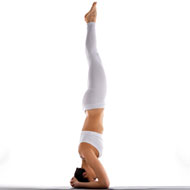- Aromatherapy (36)
- Benefits of Yoga (282)
- Home Remedies (1087)
- massage therapy (9)
- Preventive Therapy (135)
- Running (41)
- Skin Care (15)
- Stress Relief (25)
- Stretching (5)
- walking (33)
- Womens Health (14)
- Yoga Benefits for Pregnant Women (16)
- Yoga Benefits for Students (3)
- Yoga for Children (11)
- Yoga for Holistic Living (37)
- Yoga for Midlife Crisis (3)
- Yoga for Senior Citizens (2)
- Yoga for the Workplace (1)
- Yoga Health Tips (185)
- Yoga Practice during Menstruation (5)
Steps and Tips for Practicing Headstand Yoga Pose

Headstand is an advanced yoga posture that is best done by yoga experts or under the guidance of a yoga teacher. We suggest that you learn yoga from an experienced yoga teacher in a class, learn the exercise step-by-step, and then move on to the more complicated postures gradually.
A headstand is done after considerable practice and it is a great posture for building strength in the wrists and arms, and to relax the chest. It also gives you a certain body balance, helps you focus and improves the coordination among the senses and the muscles. It can be a good mental reviver.
Procedure of doing headstand:
Well, here are some basic guidelines that one should follow for getting into a head stand.
- You should begin this posture by getting into a Downward Facing Dog Pose.
- Then bend your knees and get your arms closes to the knees.
- You have to support yourself on the lower part of the arms, before trying to hop or move your body inwards. Continue to do this till you get your back straight.
- Then get one leg up and continue the movement with your lower leg. Bring your pelvis up, followed by the other leg.
- Once your feet are together, focus on a point to retain your balance.
Tips:
As simple as this sounds, this needs considerable practice. A few tips to keep in mind –
- There should be gravity between the shoulder blades in your upper back. It should not be in the lower back. Several people have the tendency to maintain this balance between the shoulder blades in the lower blade, but this should not be so.
- Alignment is the biggest factor in head stands. So with practice, you should be able to master it.
Anatomical focus:
A headstand is good for the shoulders, arms, pituitary glands and the brain. It also focuses on the wrists, lungs, spine, legs and shoulders.
Benefits of headstand:
This form of exercise is good for treating slight depression.
- It is good for strengthening the wrists, arms and shoulders.
- It also stretches the stomach.
- It is great for improving body balance.
- This posture can relieve stress and can calm the brain.
Caution:
As we've mentioned above, this is a posture that should be done under guidance. If not done correctly, it can cause injury to the neck, shoulder and back.
- Avoid headstand if you have a headache, have a cardiac problem, suffer from hypertension, or are menstruating.
- Experts believe that if you are an expert at yoga and have been doing headstands for ages, then you might be able to continue even in your pregnancy. But please check with your yoga teacher and doctor.
- RSS Feeds -
- All posts
- All comments
- Yoga for Depression in Kids According to recent statistics, antidepressants have found a whole new market...
- Headstand for Better Health Standing on your head, commonly known as “performing a headstand”...
- Yoga for Diarrhea The aim of yoga during a bout of diarrhoea is to strengthen the intestina...
- Prolapsed Uterus Exercises A prolapsed uterus occurs when your uterus falls into the vaginal canal, beca...